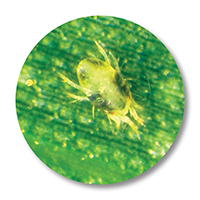Unspoken Truths About Drought-Loving Pests

Last year showed how dry conditions create the perfect playground for a few yield-robbing pests. The conditions could be ripe again for drought-loving pests to emerge.
When corn or soybean plants are stressed due to a lack of moisture, they are more susceptible to pest damage, says Julie Peterson, University of Nebraska Extension entomologist.
“The insects see a plant is weak and attack,” she says. “Or sometimes the hot and dry conditions can be more favorable for the pest.”
In other cases, beneficial insects, which keep pests in check, don’t do as well when it’s hot and dry, so the troublesome pests increase in numbers or simply do more damage.
As of late January, 70% of the U.S. was experiencing abnormally dry conditions — with 55% of the U.S. at moderate drought levels. Peterson says if droughty conditions continue, they could invite in two key pests: grasshoppers and spider mites.
Nearly 400 species of grasshoppers inhabit the 17 western states. They feed on grasses and weeds and often move to cultivated crops.
“Grasshoppers are more likely to move into irrigated crops when surrounding grassy areas and pastures start to get dry,” Peterson says. “You want to be looking at field edges and margins outside your field. If you see them, they will likely move in.”
In corn fields, grasshoppers will chew on leaves and cause defoliation.
“Based on the stage your crop is, it can withstand different levels of defoliation,” Peterson says. “Depending on the growth size of crops, you have a few different economic thresholds in terms of treatment.”
YOU MITE HAVE A PROBLEM
Spider mites are another big group of pests to worry about, Peterson says. In Nebraska, farmers face two kinds of spider mites: two-spotted spider mites and Banks grass mites.
They cause damage by piercing
leaf cell walls with their mouths and sucking out the cell’s contents.
“It is really important to know which species you have, as that will drive the treatment decisions,” Peterson says. “With insecticides and miticides, you want to make sure they work on the stage of mite you have.”
As soon as your crops experience drought stress, start scouting, Peterson says. “Always scout before you do any kind of insecticide applications.”
BANKS GRASS MITE
- Adult: Orange-colored spider mites that become green after feeding and have two dark spots that show through the transparent body.
- Nymphs: Light to dark green with six to eight legs.
- Eggs: White, round and laid in webbing on the underside of leaves.
- Timing of damage: V3 to R3
- Type of damage: Yellowing or spotting of leaf tissue. Severe cases can lead to leaf death.
- Scouting: Examine leaves of at least 10 plants in different locations of the field. Check for mite presence and record the number of infested leaves and the number of green leaves per plant.

TWO-SPOTTED SPIDER MITE
- Adult: Mite that is tiny and oval in shape. Ranges in color from orange-red to green to translucent. Body contents are often visible through the body wall, looking like two dark spots.
- Nymphs: Similar to adults but with four legs instead of eight.
- Eggs: Round, clear and attached to fine silk webbing on the undersides of leaves.
- Timing of damage: VT to R5
- Type of damage: Yellowing and defoliation of the leaves.
- Scouting: Use a hand lens to check undersides of leaves for eggs, mites and webbing.
All life stages of mites can be present at any given time, and there can be seven to 10 generations during the growing season.
GRASSHOPPER
- Adult: Yellowish brown or gray with wings and unique chevron-like black marks on the back legs. Can grow to 1¾" long.
- Nymphs: Resemble the adults but lack wings.
- Eggs: Brown to orange, elongated and found glued together in masses about 1" to 2" below the surface in uncultivated soil.
- Timing of damage: V8 to R6
- Type of damage: Leaves will be chewed away from the outer edges inward. Fresh silks will also be eaten.
- Scouting: Estimate the level of damage and number of grasshoppers per square yard in five locations. Damage is typically along field borders, but move beyond borders when scouting.









